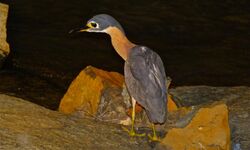Biology:White-backed night heron
| White-backed night heron | |
|---|---|

| |
| Scientific classification | |
| Domain: | Eukaryota |
| Kingdom: | Animalia |
| Phylum: | Chordata |
| Class: | Aves |
| Order: | Pelecaniformes |
| Family: | Ardeidae |
| Genus: | Calherodius Bonaparte, 1855 |
| Species: | C. leuconotus
|
| Binomial name | |
| Calherodius leuconotus (Wagler, 1827)
| |
| Synonyms | |
| |
The white-backed night heron (Calherodius leuconotus) is a species of medium-sized heron in the family Ardeidae, found in sub-Saharan Africa.
Taxonomy
The German naturalist Johann Wagler described the white-backed night heron as Ardea leuconotus in 1827.[1][2] Today the IOC World Bird List, BirdLife International and the Handbook of the Birds of the World place it in its own monotypic genus Calherodius.[3][4] Its name derives from a patch of white feathers that form a triangle on its back.[5][6]
Description
The white-backed night heron is 50–55 cm (20–22 in) in length with a black head and a short crest, or prominent feather display on the top of its head.[7] The heron has large red eyes with white-ringed markings around them, and the lores, or the region behind the eye, are a pale yellow hue.[7][8] The throat feathers are white, whereas the neck and breast are rufous, or a reddish-brown hue.[7] There is a notable white triangular patch along the back formed by the white scapulars, or small feathers, on the shoulder of the bird.[7] The belly feathers are a whitish-brown and the legs are yellow.[2][9] An immature heron can be identified by its streaked breast and the white spots on the upper-wing coverts.[5] Chicks are covered with olive-brown down.[2]
Distribution and habitat
The white-backed night heron is located throughout central and southern Africa, with a range estimated at 20,900,000 km2 (8,100,000 sq mi).[10] Its primary habitat is dense forests with neighboring waterways, particularly streams, lakes, mangroves and marshes.[3]
Behavior and ecology
The white-backed night heron can be found living individually or in pairs.[8] Nocturnal by nature, they roost in the dense vegetation of marshes and forests during the daylight hours, often nesting high within the trees.[3] Their nests are well-hidden, usually built in vegetation near water and sometimes in reedbeds, mangroves, rocks and caves.[3] The nest is built resembling a platform of sticks or reeds, 25–30 cm (9.8–11.8 in) wide.[2] They usually breed during the rainy season or early in the dry season.[3] There are two to three greenish-white eggs in a clutch, and incubation lasts roughly 24 to 26 days. The chicks leave the nest after six to seven weeks.[2] The white-backed night heron seems to be sedentary, but it has been observed in some circumstances to have migrated to locations with heavy rain.[11] White-backed night herons are known foragers, meaning they search for food primarily along waterways. They have been observed to eat fish, amphibians, mollusks and insects.[2] Though usually quiet, they let out a loud kroak call when alarmed and a taash call when disturbed.[2]
Status
The population of the white-backed night heron is believed to be stable because it does not appear to undergo significant population declines or experience any notable threats.[3] Due to these factors and its large range, the IUCN Red List has assessed the species to be of least concern.[10] The species is currently experiencing a small number of threats, including habitat loss in southern Africa and hunting in Nigeria, where they are used for traditional medicine.[3]
References
- ↑ Wagler, Johann Georg (1827) (in la). Systema avium. Stuttgartiae: J.G. Cottae. p. 189, Species 33. https://biodiversitylibrary.org/page/54130706.
- ↑ 2.0 2.1 2.2 2.3 2.4 2.5 2.6 "White-backed Night Heron Nycticorax leuconotus (Wagler)". IUCN-SSC Heron Specialist Group. 2011. http://www.heronconservation.org/styled-5/styled-59/.
- ↑ 3.0 3.1 3.2 3.3 3.4 3.5 3.6 "Species factsheet: Calherodius leuconotus". BirdLife International. 2016. http://datazone.birdlife.org/species/factsheet/white-backed-night-heron-calherodius-leuconotus/text.
- ↑ Martínez-Vilalta, A.; Motis, A.; Kirwan, G. M. (2016). "White-backed Night-heron (Calherodius leuconotus)". in del Hoyo, J.; Elliott, A.; Sargatal, J. et al.. Handbook of the Birds of the World Alive. Barcelona: Lynx Edicions. http://www.hbw.com/species/white-backed-night-heron-calherodius-leuconotus.
- ↑ 5.0 5.1 Hancock, Peter; Weiersbye, Ingrid (2015). Birds of Botswana. Princeton University Press. p. 62. ISBN 9781400874170. https://books.google.com/books?id=H-d0CgAAQBAJ&pg=PA62.
- ↑ Template:IOC birdlist
- ↑ 7.0 7.1 7.2 7.3 Borrow, Nik; Demey, Ron (2013). Birds of Senegal and The Gambia. Bloomsbury. p. 42. ISBN 9781408171011. https://books.google.com/books?id=fkuCBAAAQBAJ&pg=PA42.
- ↑ 8.0 8.1 Redman, Nigel; Stevenson, Terry; Fanshawe, John (2010). Birds of the Horn of Africa. Bloomsbury. p. 50. ISBN 9781408135761. https://books.google.com/books?id=NPfUBAAAQBAJ&pg=PA50.
- ↑ Newman, Kenneth (2002). Newman's Birds of Southern Africa. Struik. p. 90. ISBN 9781868727353. https://books.google.com/books?id=yYqLZtf5w0gC&pg=PA90.
- ↑ 10.0 10.1 Cite error: Invalid
<ref>tag; no text was provided for refs namedIUCN - ↑ A. P. Martin. "Whitebacked Night Heron". The Atlas of Southern African Birds. p. 67. http://sabap2.adu.org.za/docs/sabap1/077.pdf.
Wikidata ☰ {{{from}}} entry
 |


